
To make easy pizza dough, start by activating Platinum Yeast with warm water and sugar until foamy. Mix flour, sugar, salt, olive oil, and the yeast mixture into a stiff dough. Knead it until smooth and elastic, then let it rise covered in a warm spot until doubled. Roll out the dough, shape the crust, add toppings, and bake at a high temperature until golden. Keep following to uncover tips that perfect your homemade pizza every time.
Gather Ingredients and Prepare Yeast
Before you begin mixing your dough, gather 1 packet of Platinum Yeast from Red Star, 1 and 1/3 cups of warm water (between 100-110°F), and your preferred flour, ideally unbleached all-purpose or bread flour for the best texture.
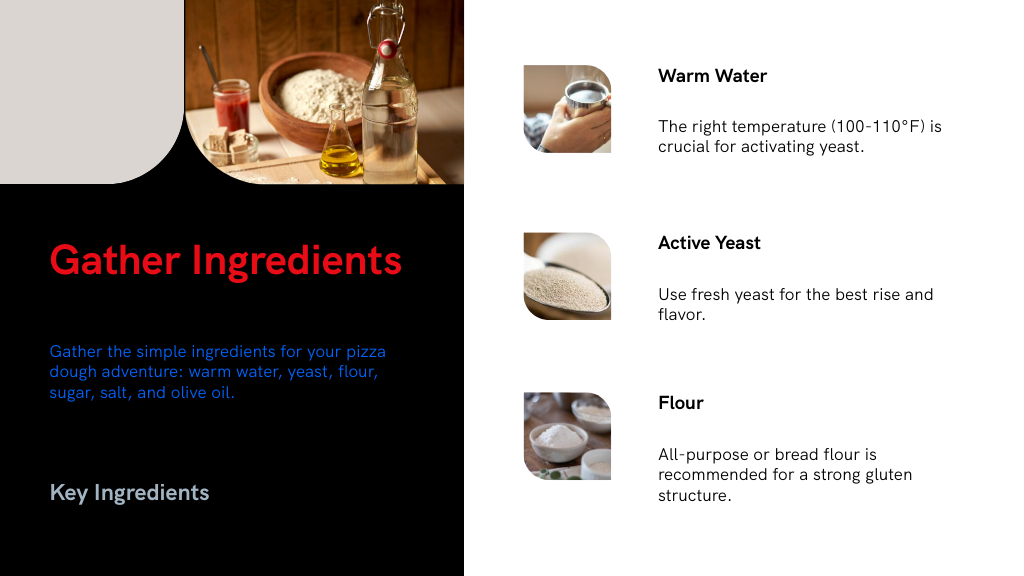
To activate the yeast for pizza dough, combine the warm water with 1 tablespoon of sugar in a small bowl, then sprinkle the yeast on top. Let it sit undisturbed for about 5 minutes until it becomes foamy.
Combine warm water and sugar, sprinkle yeast on top, and let sit 5 minutes until foamy to activate.
Make sure the water isn’t too hot—anything above 130°F can kill the yeast, which will stop your homemade pizza dough from rising properly. Always check the yeast's expiration date to verify freshness, as prepared yeast is essential for a good dough rise.
Mix Dough Ingredients
Once your yeast is foamy and active, you can start mixing the rest of your dough ingredients. In a large bowl, combine 3 to 4 cups of all-purpose or bread flour with 1 tablespoon sugar and 1 teaspoon salt. Gradually add 2 tablespoons of extra virgin olive oil along with the foamy yeast mixture.
Stir everything until it forms a stiff dough. If it feels too sticky, sprinkle in flour little by little until the dough is slightly tacky but smooth to the touch.
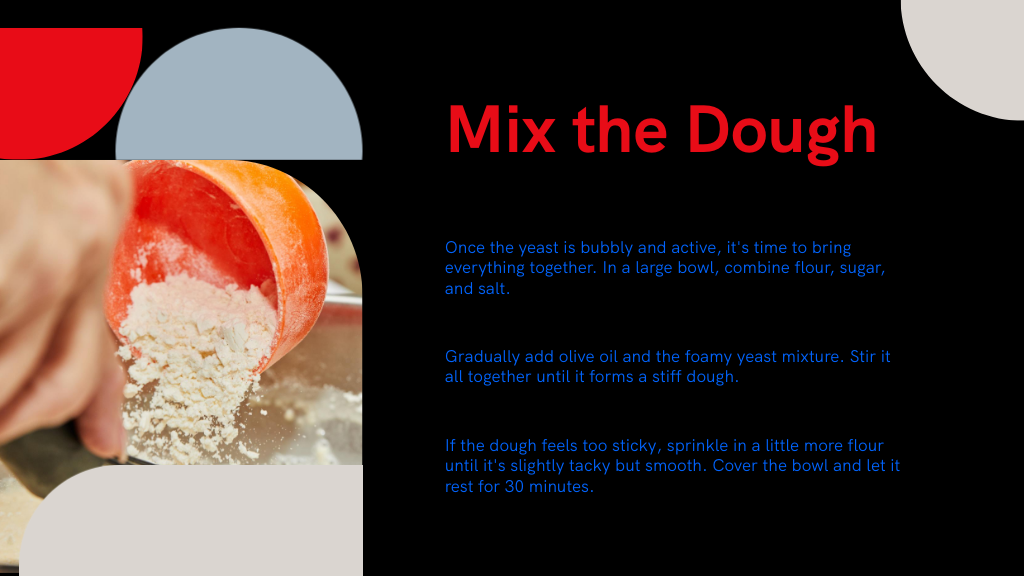
Cover the bowl with plastic wrap or a damp towel and let it rest for about 30 minutes to improve texture and elasticity. This simple approach is key when learning how to make dough and guarantees you’re on track with the best pizza dough recipe.
Knead the Dough
Start kneading the dough on a floured surface, using the heel of your hand to push it away, then fold it over and rotate. This process is key to your easy pizza dough recipe. Knead the dough for 3-5 minutes until it’s smooth and elastic. If it’s sticky, sprinkle in flour gradually—up to ½ cup—to get the right consistency.
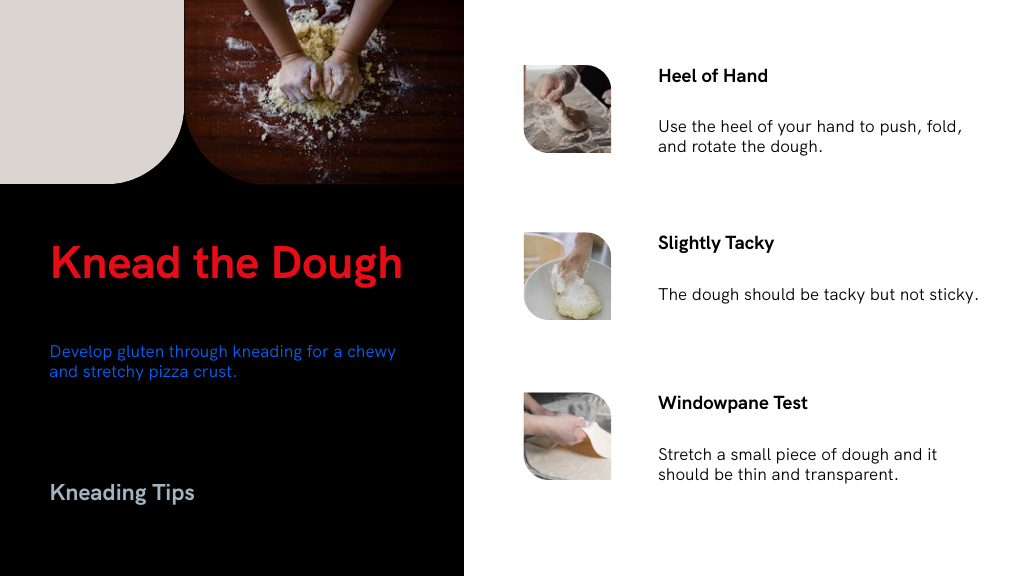
Here’s what to keep in mind:
- Use the heel of your hand to push, fold, and rotate evenly.
- Dough should become slightly tacky but not sticky.
- Perform the windowpane test by stretching a small piece without tearing.
- Proper kneading develops gluten, essential for texture and stretch.
Following these steps guarantees your dough is ready for the next phase.
Let the Dough Rise
Once you've kneaded your dough, it's time to let it rise in a warm spot around 70°F to 80°F for 10 to 60 minutes. Place the dough in a lightly greased bowl and cover it with a damp towel to keep it from drying out. You'll know it's ready when it doubles in size, showing that the yeast has done its job.
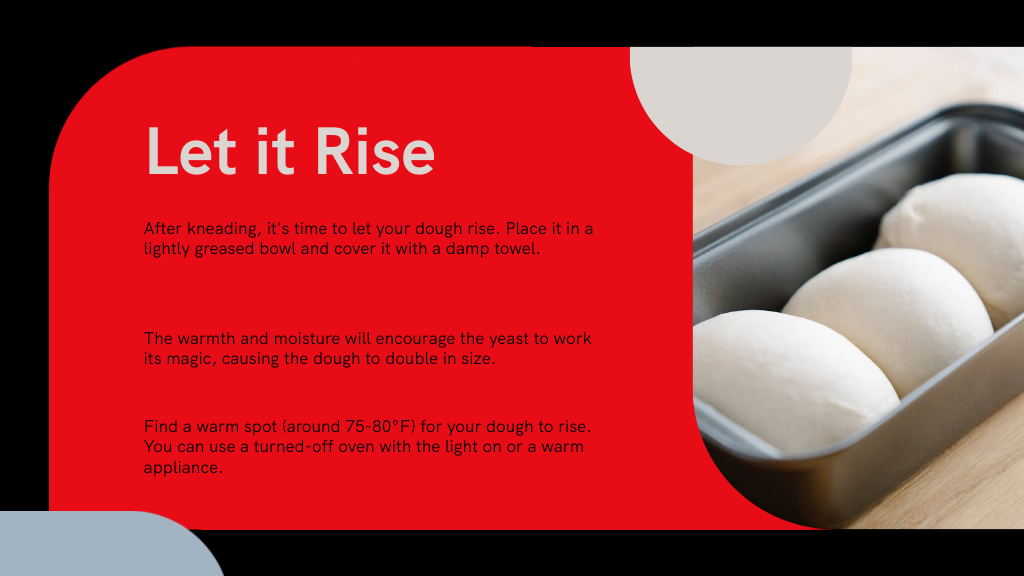
Ideal Rising Temperature
Although dough can rise at various temperatures, aiming for around 75°F to 80°F (24°C to 27°C) is best to activate the yeast properly and secure a good fermentation.
This ideal rising temperature encourages the yeast for pizza to work efficiently, producing the right texture and flavor. If your kitchen’s cooler, place the dough in a turned-off oven or near a warm appliance to maintain warmth. Avoid temperatures above 100°F (38°C), as heat can kill the yeast.
Remember these tips for the ideal rising temperature:
- Keep dough in a warm, draft-free spot.
- Use a thermometer to check the environment.
- Avoid overheating to preserve yeast activity.
- Monitor the dough’s rise to guarantee proper fermentation.
Duration for Dough Rise
If you want your pizza dough to develop the best texture and flavor, let it rise at room temperature for 60 to 90 minutes, or until it has doubled in size.
This dough rise time allows the yeast to work its magic, resulting in a tender, flavorful crust. If you’re short on time, a quick pizza dough rise of about 10 minutes can still work, but the dough might be less tender and slightly less flavorful.
For even better results, you can refrigerate the dough overnight after it has risen; this slow fermentation enhances flavor complexity.
Covering Techniques for Rising
To guarantee your dough rises properly, you’ll want to cover it with a damp towel, plastic wrap, or aluminum foil to keep moisture and warmth locked in during proofing.
This step is essential when learning how to make pizza dough for a soft, airy crust. Here’s how to cover your dough effectively:
- Use a damp towel to prevent drying out.
- Plastic wrap creates an airtight seal.
- Aluminum foil reflects heat to maintain warmth.
- Place the covered dough in a warm spot, like an oven with the light on.
Following this pizza dough recipe tip, let the dough rise until doubled in size. This guarantees ideal yeast activity and better flavor development.
Roll Out the Dough
Lightly flour your work surface and hands to keep the dough from sticking as you roll it out. Start by flattening your dough into a disc shape; this makes it easier to stretch evenly and prevents it from shrinking back.
Using a rolling pin, gently roll the dough from the center outward, aiming for an even thickness of about ½ inch—this creates the perfect base for your pizza crust recipe. If the dough resists stretching, cover it and let it rest for 5-10 minutes to relax the gluten.
Finally, pinch the dough around the edges to form a raised border. This step not only helps contain your toppings but also adds a nice, decorative touch to your easy pizza dough, setting you up for a delicious pie.
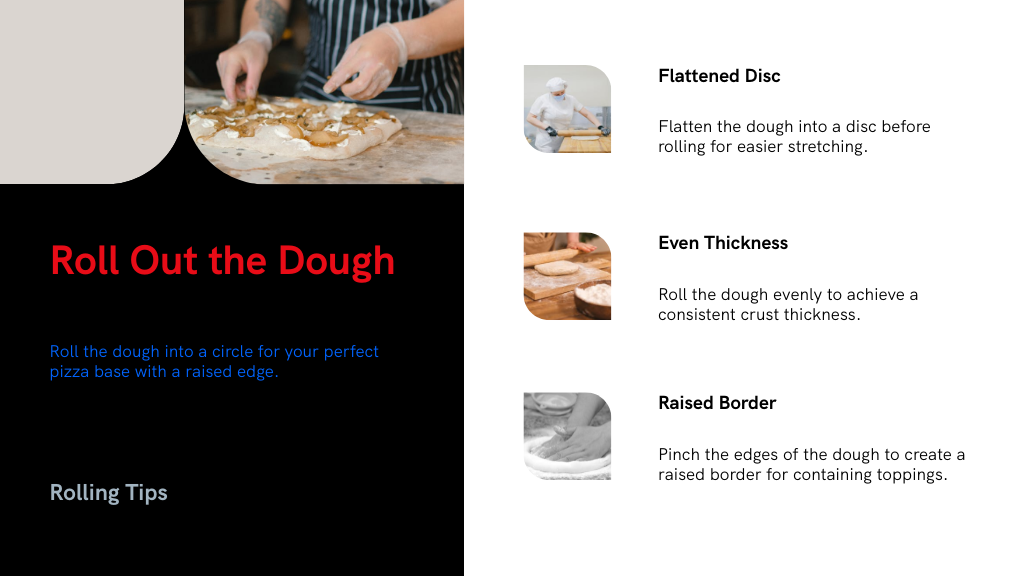
Add Sauce and Toppings
Once your dough is rolled out, spread a thin layer of pizza sauce evenly over the surface, leaving a small border around the edges to secure a perfect crust.
Knowing how to make pizza at home gets easier when you follow these simple steps to add sauce and toppings:
- Sprinkle a light layer of shredded mozzarella cheese over the sauce to help toppings stick.
- Choose your favorite toppings—pepperoni, veggies, or cooked meats—and spread them evenly.
- For extra flavor, drizzle olive oil or sprinkle minced garlic on the crust.
- Avoid overloading toppings to prevent sogginess and guarantee even cooking.
This method guarantees your homemade pizza is balanced and delicious, setting you up perfectly for baking.
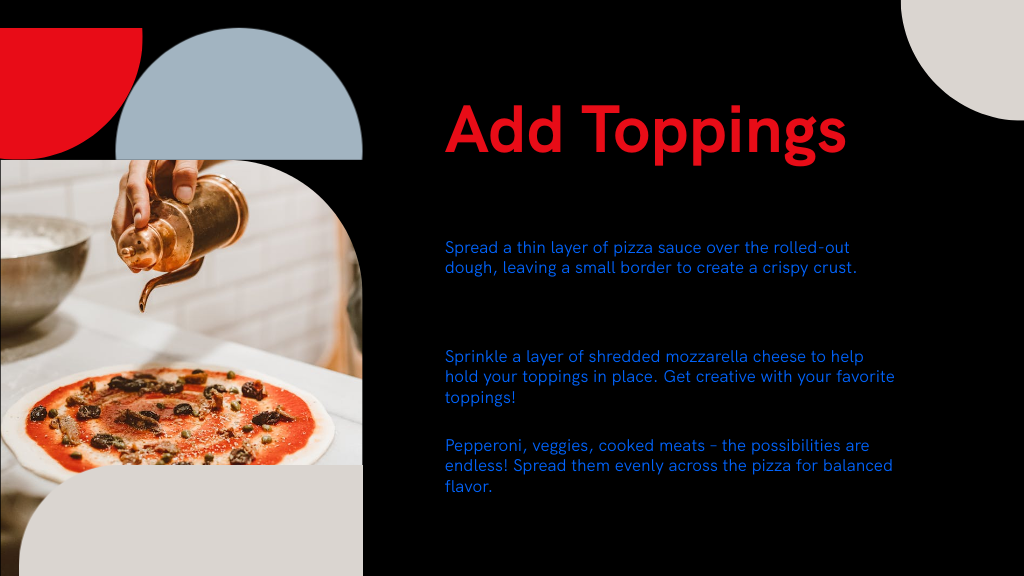
Bake the Pizza
First, make sure your oven is preheated to 475°F so your pizza cooks evenly. Keep an eye on the baking time, usually 10-15 minutes, to get that perfect golden crust. You'll know it's ready when the cheese is bubbly and the edges are nicely browned.
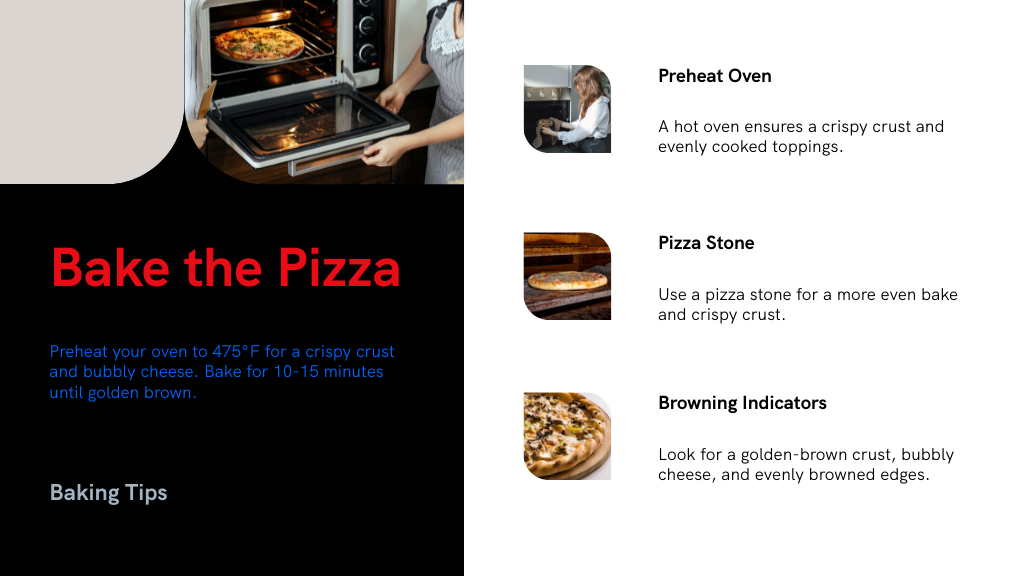
Oven Temperature Setup
How hot should your oven be to bake the perfect pizza? For the best results with your quick pizza dough recipe, set your oven temperature setup to 475°F (246°C). Preheat for 15–20 minutes to guarantee a crispy crust.
Here’s what you need to do:
- Preheat the oven to 475°F and let it reach full temperature.
- Use a pizza stone or a lightly greased baking sheet with olive oil and cornmeal to prevent sticking.
- Carefully slide your assembled pizza onto the stone or pan to keep the heat consistent.
- Optionally, rotate the pizza halfway through baking for even cooking.
Following these steps will help you achieve a golden-brown crust and perfectly melted cheese every time.
Baking Duration Tips
Although preheating your oven is essential, knowing how long to bake your pizza is just as important to get that perfect crust and melted cheese.
For an easy pizza crust recipe, bake your pizza at 475°F (246°C) for 10 to 15 minutes. Keep an eye on it to achieve a golden brown crust and bubbly cheese.
If you’re using a pizza stone, sprinkle it with cornmeal first to prevent sticking and make transferring easier. When your pizza has lots of toppings, you might want to pre-bake the crust for 5 minutes before adding them to avoid sogginess.
Remember, after baking, let your pizza cool for about 10 minutes so the cheese sets and the crust stays firm. This is the key to knowing how long to bake homemade pizza perfectly every time.
Crust Browning Indicators
When should you know your pizza is perfectly baked? When the crust shows the right browning indicators, you’ve nailed how to make pizza dough with your chosen pizza dough mix. Here’s what to look for:
- The crust turns a golden brown, signaling it’s cooked through and crisp.
- Cheese is melted and has slight browning spots.
- The edges brown evenly; if not, rotate the pizza halfway through baking.
- The baking temperature stays between 475°F to 500°F for ideal results.
After baking, let your pizza cool for 10 minutes to keep the crust firm and flavorful. Watching these signs helps you achieve that perfect pizza crust every time.
Conclusion
Now that you’ve mastered these 7 simple steps, you’re just minutes away from enjoying homemade pizza that beats any takeout. Did you know that 93% of Americans say pizza is their favorite comfort food? With this easy dough recipe, you can customize every pie to your taste and impress your friends. So go ahead, roll out that dough, add your favorite toppings, and bake a delicious pizza that’s truly your own!















